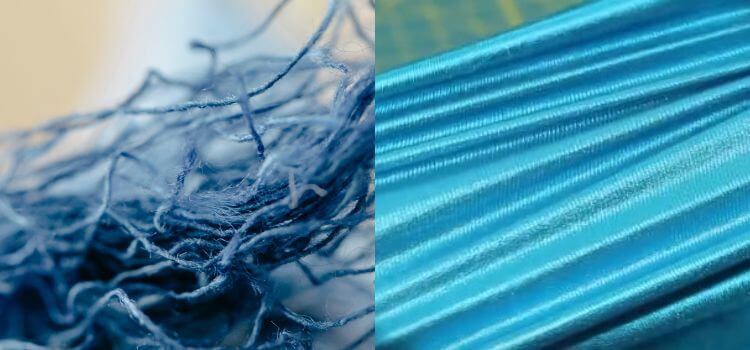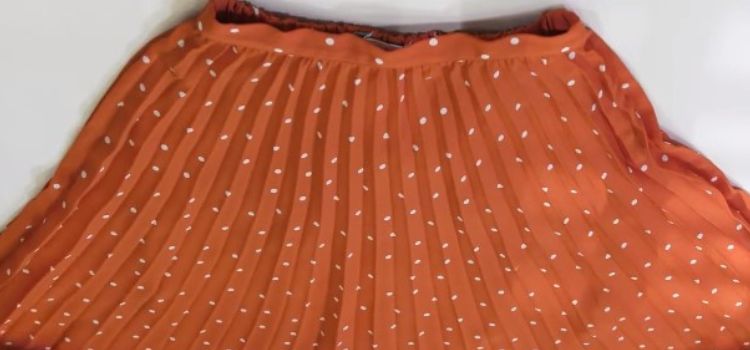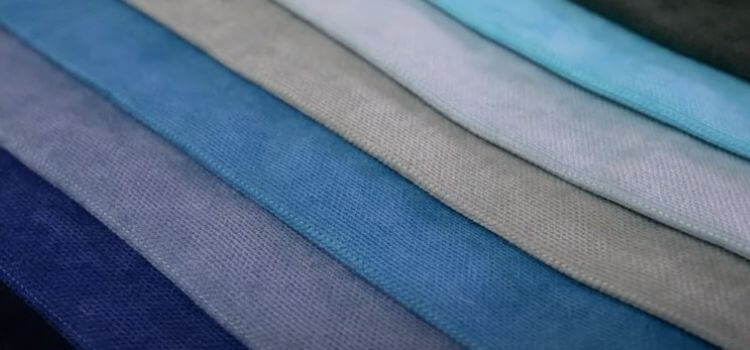If you buy via any of our links, there will be no additional cost to you, and we will receive a tiny commission. More information is available on our Affiliate Disclosure page.

Is Rayon Stretchy?
Is Rayon Stretchy? Learn about the various factors that determine Rayon’s capacity for stretching and how it can be applied to clothing.
The amazingly versatile and pleasant fabric rayon has become a mainstay in a wide range of apparel items, from airy summer dresses to elegant evening gowns and everyday basics. Because it combines the appealing qualities of both natural and synthetic fibers, it appeals to both designers and customers and is a popular choice.
Through a particular procedure, Rayon is produced from natural cellulose sources like wood pulp, bamboo, or cotton. It combines the comfort and breathability of natural fibers with the adaptability and toughness of synthetic ones.
Not all rayon fabrics are equally stretchy; their elasticity is influenced by a number of parameters, including composition, weave, blend, processing, and finishing.
For a number of reasons, it is essential to comprehend how stretchy Rayon is. It affects fit, comfort, design, durability, and adherence to customer preferences. Knowing Rayon’s stretch characteristics will help you make wise decisions regarding activewear, loungewear, or formal dress.
By illuminating Rayon’s forms, characteristics, and uses in this investigation, we aim to make it easier for readers to choose rayon clothing that matches their personal preferences for comfort and style.
Join us on this adventure as we reveal the elastic secrets of Rayon, appealing to those who love fashion, are knowledgeable about textiles, and are interested in the clothes they wear.

How Stretchy is Rayon?
The stretchiness of rayon can vary widely depending on several factors, including the type of rayon, its blend with other fibers, the weave or knit of the fabric, and any post-production treatments. As a general guideline:
Rayon (Viscose) Natural:
Pure, natural rayon, often referred to as viscose rayon, typically has limited stretch. It is not as stretchy as synthetic fibers like spandex or elastane and is closer in stretch properties to natural fibers like cotton or silk. Natural rayon can have some minimal give, but it does not provide significant elasticity.
Rayon/Rayon Blend:
Rayon is frequently blended with other fibers to enhance its stretchiness. For instance, a rayon-spandex blend is standard in the production of stretchy garments. In such combinations, the degree of stretch can be considerable, and these fabrics can provide a good amount of elasticity, making them suitable for form-fitting and comfortable clothing.
Weave and Knit:
The way rayon fibers are woven or knitted into fabric can significantly affect their stretchiness. Looser weaves or knits tend to result in more stretchy fabrics, while tighter weaves or knits may limit stretch.
Processing and Finishing:
The manufacturing process and any chemical or mechanical treatments applied to the rayon can also impact its stretch properties. Some medicines can increase or decrease the stretchiness of the fabric.
Consumer Expectations:
What is considered “stretchy” can vary from person to person. Some individuals may find that even natural rayon provides adequate comfort and flexibility for their clothing needs, while others may prefer fabrics with higher stretch for specific applications.
The stretchiness of rayon can range from minimal to quite substantial, depending on the specific type of rayon and how it is processed, blended, woven, or knitted.
When selecting rayon garments, it’s essential to consider your preferences for comfort, fit and intended use to ensure that the fabric’s stretch properties align with your needs and expectations.
Whether rayon is stretchy or not depends on various factors, and it can range from non-stretchy in its natural form to highly elastic when blended or processed accordingly. When purchasing rayon garments, it’s essential to consider your specific preferences for comfort and fit, as well as the intended use of the clothing, to ensure it meets your expectations for stretchiness.

Is 100 Rayon Stretchy?
Pure 100% rayon (viscose rayon) does have some degree of stretch, but it is not highly elastic or stretchy like materials that contain spandex or elastane. The stretch in 100% rayon is typically limited and more akin to the natural stretch found in fibers like cotton or silk.
It has some give, allowing the fabric to deform when pulled, but it does not provide significant elasticity or bounce-back.
The stretchiness of 100% rayon can also vary depending on factors such as the specific manufacturing process, the weave or knit of the fabric, and any post-production treatments applied.
However, in general, it is not considered a highly stretchy material.
If you’re looking for clothing with substantial stretch and elasticity, consider garments made from rayon blends, such as rayon-spandex blends, which offer a much higher level of stretch and comfort.
These blends combine the softness and drape of rayon with the stretch properties of spandex to create clothing that is both comfortable and form-fitting.
Does Rayon Stretch When Wet?
Yes, rayon tends to stretch when it gets wet. This characteristic is often referred to as “water elongation.” When rayon fibers absorb moisture, they can expand and become more flexible, leading to an increase in the length and width of the fabric.
This property is one reason why rayon is often chosen for certain types of clothing, such as swimsuits and summer dresses, where a bit of extra give and comfort when wet is desired.
It’s important to note that this stretching is temporary and reversible. Once the wet rayon fabric dries, it typically returns to its original size and shape.
However, during the wet phase, the fabric may become more delicate and susceptible to damage, so it’s essential to handle wet rayon garments with care.
Keep in mind that the extent of stretching when wet can vary depending on the specific type of rayon, its blend with other fibers, and how it was manufactured.
Some rayon fabrics may stretch more than others when exposed to moisture. If you have a particular rayon garment and are concerned about its stretching when wet, it’s a good idea to follow the care instructions provided by the manufacturer to help maintain its shape and fit.
Does Rayon Stretch with Wear?
Rayon, as a fabric, can experience some degree of stretching with wear, especially if it’s subjected to tension or pressure. However, the extent of trying with wear depends on several factors:
Fabric Type:
The specific type of rayon can influence its stretchiness. For example, natural rayon (viscose) tends to have limited stretch, similar to natural fibers like cotton or polyester and is less prone to stretching out of shape with wear.
Blends:
If rayon is blended with other fibers, such as spandex or elastane, it can provide more elasticity and resistance to stretching out of shape. Rayon-spandex blends are known for their stretch and recovery properties.
Weave and Construction:
The weave or knit of the fabric can also affect its stretch with wear. Fabrics with looser weaves or knits may be more prone to stretching, while those with tighter weaves tend to maintain their shape better.
Fit:
Garments that are too tight or are subject to repeated stretching due to body movement may experience more noticeable extension with wear.
Care and Maintenance:
Proper care, such as following washing and drying instructions, can help maintain the shape and elasticity of rayon garments. Excessive heat in washing or drying can contribute to stretching and deformation.
It’s important to note that while rayon can experience some stretching with wear, it is generally not as prone to permanent extension as some other fabrics.
Additionally, the extent of stretching can vary from one rayon garment to another based on the factors mentioned above.
If maintaining the original shape and fit of your rayon clothing is a concern, consider choosing garments with rayon blended with spandex or elastane, as these blends offer enhanced stretch and recovery properties.
Proper care and handling, avoiding excessive stretching, and following care instructions can also help prolong the life and shape of your rayon garments.
Is Polyester and Rayon Stretchy?
Polyester and rayon are two different types of fabrics, and their stretchiness varies depending on how they are made, whether they are blended with other fibers, and the specific weave or knit of the material. Let’s explore the stretchiness of each material:
Polyester:
Polyester by itself is not inherently stretchy. It is a synthetic fiber known for its durability, moisture-wicking properties, and resistance to wrinkles and stretching.
Pure polyester fabrics tend to be stiff and have slight natural elasticity. However, polyester can be blended with other fibers, such as elastane or spandex, to add stretch and improve flexibility.
Fabrics labeled as “polyester-spandex” blends are known for their stretchiness and are commonly used in sportswear, activewear, and form-fitting clothing.
Rayon:
Rayon, often referred to as viscose rayon, has some natural stretch, but it is not highly elastic like spandex or elastane. Pure rayon fabrics have limited stretch and behave more like natural fibers, such as cotton or silk.
However, the stretchiness of rayon can vary depending on factors like its specific type, blending with other fibers, weaving, and processing.
Rayon-spandex blends, for example, are known for their stretch and are used in garments where comfort and flexibility are desired.
While pure polyester is not stretchy, rayon has some natural stretch but is not highly elastic. The degree of stretchiness in both fabrics can be altered by blending them with other fibers like spandex or elastane.
If you are looking for stretchy clothing, especially for activewear or form-fitting garments, you’ll want to consider fabrics that are blends of polyester with spandex or rayon with spandex, as these combinations provide the desired elasticity and comfort.
Rayon vs. Cotton vs. Nylon vs. Polyester: Which is Most Stretchy?
The stretchiness of fabrics can vary significantly, and it depends on various factors, including the specific type of fiber, the weave or knit of the material, and any blending with other fibers. Here’s a comparison of the stretchiness of rayon, cotton, nylon, and polyester:
Rayon:
Rayon, particularly natural rayon (viscose), has some natural stretch, but it is not highly elastic compared to synthetic fibers like spandex or elastane.
Rayon’s stretchiness is similar to that of natural fibers like cotton or silk.
Blending rayon with spandex or elastane can significantly increase its stretchiness.
Cotton:
Cotton, a natural fiber, has limited inherent stretch and elasticity.
It can stretch slightly but does not provide significant bounce-back or recovery.
Cotton fabrics may become more pliable and comfortable with wear but do not offer the stretch found in synthetic blends.
Nylon:
Nylon, a synthetic fiber, is known for its excellent elasticity and stretchiness.
These fabrics can stretch significantly and recover their original shape well.
Nylon is often used in activewear, hosiery, and undergarments for its stretch properties.
Polyester:
Pure polyester is not inherently stretchy and is known for its durability and resistance to stretching.
It can be blended with spandex or elastane to add significant stretch and elasticity.
Polyester-spandex blends are commonly used in form-fitting clothing, sportswear, and swimwear.
When comparing the stretchiness of these fabrics:
Nylon is the most stretchy among the options listed, offering significant elasticity.
Rayon and cotton have limited inherent stretch and behave more like natural fibers.
Polyester is not naturally stretchy but can become highly elastic when blended with spandex or elastane.
The degree of stretchiness can also vary within each fabric type based on factors like the specific type of fabric, weave or knit, and any added stretch fibers.
If you’re looking for highly stretchy fabrics, consider those blended with spandex or elastane, as they provide the most significant stretch and flexibility.
Is Rayon and Spandex Stretchy?
Yes, rayon blended with spandex (or elastane) can be very stretchy. Spandex is a synthetic fiber known for its exceptional elasticity and stretch properties, and when combined with rayon, it imparts a significant amount of stretch to the fabric.
Rayon, on its own, has some natural stretch but is not highly elastic. However, when combined with spandex, the resulting blend becomes much more stretchy and flexible.
This combination of rayon and spandex is commonly used in the production of clothing items where stretch and comfort are desired, such as form-fitting dresses, leggings, activewear, and swimwear.
The presence of spandex in the blend allows the fabric to stretch in multiple directions, providing a snug and comfortable fit while maintaining its shape and elasticity.
It makes rayon-spandex blends popular choices for garments that require both comfort and flexibility.
What Does Stretchy Rayon Feel Like?
Stretchy rayon, particularly when blended with spandex or elastane, has a distinct feel that combines the characteristics of both rayon and stretch fiber. Here’s what stretchy rayon typically feels like:
Soft and Smooth:
Like regular rayon, stretchy rayon maintains a soft and smooth texture. It feels comfortable against the skin and has a luxurious, silky feel.
Slight Elasticity:
The addition of spandex or elastane imparts a noticeable degree of elasticity to the fabric. This elasticity allows the material to stretch when pulled and then recover its original shape once the tension is released.
Stretch and Resistance:
Stretchy rayon feels slightly more resilient and offers resistance when pulled. You can feel the fabric stretching as you apply tension, and it returns to its original shape when released.
Lightweight:
Stretchy rayon, like regular rayon, remains lightweight, making it comfortable to wear and allowing it to drape gracefully.
Cool and Breathable:
Stretchy rayon retains the breathable and moisture-wicking properties of rayon, helping keep you cool and comfortable.
Flexible:
The elasticity of the fabric gives it a flexible quality, allowing for ease of movement without feeling restrictive.
Versatile:
Stretchy rayon can be used in various clothing items, including leggings, dresses, tops, and activewear, where both comfort and stretch are desired.
The feel of stretchy rayon is a combination of the softness and smoothness of rayon and the stretch and resilience provided by the spandex or elastane fibers.
How To Stretch Rayon?
Stretching rayon is possible, but it must be done with care and caution because rayon fibers are not as elastic as other fabrics, such as spandex or elastane.
Here are some instructions for stretching a rayon garment or fabric:
Always check the care label on your rayon item before wearing it since excessive stretching or inappropriate maintenance might harm the fabric.
Prepare the fabric as follows:
Begin by lightly wetting the rayon fabric. It can be accomplished by spritzing it with water until it is uniformly moist but not soaked.
Determine the Area to Stretch:
Determine the precise location that needs stretching. It might be the waistband, sleeves, or any other area of the clothing that is excessively tight.
Stretch the Fabric Gently:
Hold the fabric at both ends of the stretchable area.
Stretch the cloth slightly with mild, steady pressure.
Avoid tugging too hard or applying too much power, as rayon can be damaged or distorted when subjected to severe stress.
Hold and Wait for it To Dry:
Allow the stretched portion to air dry while holding it. To speed up the drying process, use a hairdryer in a low or relaxed setting.
Maintain the stretched shape until the fabric has completely dried.
Make use of a Stretch Block:
You can use a stretch block or a form that matches the intended shape to help keep the stretched position while the fabric dries if you’re stretching a specific location, such as a neckline or waistband.
Ironing with Steam:
Some people use a steam iron on low heat to assist in relaxing the fibers and make stretching easier. To avoid harming the cloth with heat or steam, however, extra caution must be exercised.
Stretching Repeatedly:
If the initial stretching did not produce the intended results, you can carefully repeat the process, taking care not to overstretch and distort the fabric.
Professional Changes:
If you need to make significant changes or are concerned about ruining the fabric, it’s best to see a skilled tailor or seamstress who can make precise adjustments without compromising the rayon’s quality.
Examine the Fit:
When the cloth has dried, try it on to check if it fits. If it is still not stretched enough, repeat the operation, but avoid overstretching to avoid damage.
Wear and Store Correctly:
Wear and store the garment with care after stretching it to keep its shape. Hanging rayon products on hangers may cause them to stretch out of shape.
Consider Professional Changes:
If you need to make considerable changes to the fit of your rayon garment, it’s usually preferable to call a professional tailor or seamstress who can make exact adjustments without risking fabric damage.
It’s crucial to note that while stretching rayon is possible, it may not be as effective as stretching materials that are naturally more elastic, such as spandex or elastane. Furthermore, repetitive stretching and shrinking of rayon can reduce its durability and longevity, so employ this procedure sparingly and only when essential.
While these differences allow some flexibility in the stretching process, stretching rayon remains a delicate procedure that should be approached with delicacy to avoid fabric damage or distortion. Furthermore, testing rayon is often used as a temporary method to change the fit of a garment gently.
If you require significant modifications or a different fit, it is preferable to seek the assistance of a professional tailoring or alteration service.
Is Rayon Stretchy in Jeans?
Rayon is a rare fabric used in the production of jeans. Jeans are typically made of denim, a strong and long-lasting cotton twill fabric. Denim, on its own, does not have much stretch, and it is noted for its toughness and resistance to stretching.
Some modern jeans, on the other hand, are made from a blend of fibers, such as cotton blended with a small percentage of spandex or elastane.
This combination, together with stretch fibers like spandex, lends specific jeans their stretchiness. These jeans are also known as stretch jeans or stretch denim.
If your pants are labeled “stretch jeans” or something similar, they may include spandex or elastane to give stretch and comfort.
The inclusion of rayon in jeans is uncommon, and it is not a standard fiber utilized in the production of jeans owing to its stretch capabilities.
The addition of spandex or elastane fibers causes most jeans’ stretchiness.
Does Polyester Rayon Blend Stretch?
A polyester-rayon blend fabric typically has a limited amount of elasticity on its own.
Polyester and rayon are not stretchy fibers by nature, and when combined, they preserve their non-stretchy qualities.
If you want a stretchy fabric, search for a blend that includes a stretch fiber like spandex or elastane.
Materials labeled “polyester-rayon-spandex” would include spandex or elastane to offer the appropriate stretch and elasticity.
These blends are frequently used in clothing items that require both comfort and flexibility, such as specific types of dresses, tops, or activewear.
How to Remove Stretch from Rayon Fabric?
Removing stretch from rayon fabric is more challenging than stretching it because rayon is not a highly elastic material. However, if you’ve stretched rayon fabric and want to restore it to its original shape, you can try the following steps:
Materials You’ll Need:
Clean water in a spray bottle
Towel
Iron and ironing board
Moisten the Fabric:
Start by lightly misting the stretched rayon fabric with clean water from a spray bottle. You want to make the fabric slightly damp but not soaked.
Lay the Fabric Flat:
Lay the dampened fabric flat on a clean towel. Smooth out any wrinkles or distortions in the fabric to the best of your ability.
Use an Iron:
Set your iron to a low heat setting (usually labeled “Rayon” or “Low” on the temperature dial) without steam.
Place a clean, dry cloth (such as a thin cotton or muslin cloth) over the damp rayon fabric. The material acts as a protective barrier to prevent direct contact between the iron and the fabric.
Gently press the iron onto the cloth-covered rayon fabric. Use only a slight pressure or excessive heat.
Move the iron in a slow, continuous motion over the material, working in small sections.
Continue this process until you have covered the entire stretched area. The combination of gentle heat and moisture should help relax the fibers and reduce the stretch.
Allow to Cool and Dry:
After ironing, allow the fabric to cool completely. It helps the fibers set in their new (less stretched) position.
Ensure the material is dehydrated before wearing or storing it.
Check the Fit:
After the fabric has cooled and dried, assess the fit of the garment to see if the stretching has been reduced. The material may not return ultimately to its original shape, but it should become less stretched.
Wear and Store Properly:
After treating the fabric, wear and store the garment with care to help maintain its shape. Avoid hanging rayon items on hangers that could stretch them out of shape.
It’s important to note that while this method may help reduce the stretch in rayon fabric to some extent, it may not fully restore it to its original shape, especially if the material has been stretched significantly.
Additionally, rayon is a delicate material, so always exercise caution when using heat and moisture to manipulate it. If you have concerns about stretching or restoring a particular garment, consider consulting a professional tailor or seamstress for advice and assistance.
Is Rayon Generally Considered a Stretchy Fabric?
Rayon is not generally considered a highly stretchy fabric when compared to materials like spandex or elastane. Pure, natural rayon, often referred to as viscose rayon, has limited inherent stretch and behaves more like natural fibers such as cotton or silk. Its stretchiness is relatively minimal.
However, rayon’s stretchiness can vary depending on factors like the specific type of rayon, any blending with other fibers, the weave or knit of the fabric, and any post-production treatments. When blended with spandex or elastane, rayon can become significantly more stretchy and elastic, making it suitable for form-fitting and comfortable clothing.
Rayon is a flexible fabric that combines softness, comfort, and breathability. Depending on how it’s processed and whether it’s combined with stretch fibers, its stretch qualities can range from negligible to substantial. Rayon-spandex blends, in particular, are noted for their stretch and flexibility, making them perfect for a wide range of garment applications.
When shopping for rayon clothing, it’s critical to understand the fabric’s specific properties and if it satisfies your stretchiness and comfort requirements. The adaptability of rayon allows it to be utilized in a wide range of garment applications, catering to varied preferences and needs, whether for casual wear, formal clothes, or activewear.

